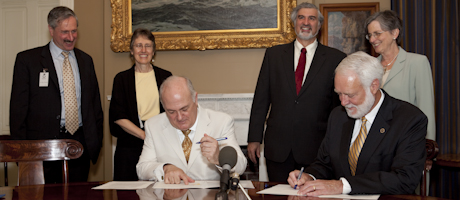GW students and faculty will have unprecedented access to the world’s largest museum complex under a memorandum of understanding between the university and the Smithsonian Institution signed today.
The agreement includes a collaborative program in museum studies, expanded relationships between the Smithsonian and GW’s departments of biology, anthropology and American studies, and a fellowship for GW students at the Smithsonian.
The announcement was made earlier today at the Smithsonian Castle, the institution’s first building and home to its administrative offices. GW and the Smithsonian also announced the establishment of an “opportunity fund,” which will support joint research projects.
Many of the details of the future partnership will be decided by an advisory committee composed of an equal number of representatives from the Smithsonian and GW and two co-chairs, one from each institution.
Leaders from both the university and Smithsonian attended the ceremony, including President Steven Knapp; Provost Steven Lerman; Peg Barratt, dean of the Columbian College of Arts and Sciences; and Wayne Clough, secretary of the Smithsonian Institution.
“This agreement builds on a century of partnership and will enhance the contribution both institutions make to the knowledge, education and cultural enrichment of the American public and visitors to Washington from around the world,” said Dr. Knapp.
Dr. Barratt said that the memorandum of understanding “marks a new chapter in our long association with the Smithsonian Institution to advance learning and discovery.
“From internships for our museum studies and art history students to our collaboration with Smithsonian curators on special exhibits on the evolution of the primate brain and the biological lineage of dinosaurs, we are proud of the partnerships we have established with this prestigious organization,” she said.
Founded in 1846, the Smithsonian is the world’s largest museum and research complex, consisting of 19 museums and galleries, the National Zoological Park and nine research facilities. The total number of objects, works of art and specimens at the Smithsonian is estimated at 137 million.
The agreement expands on the university’s myriad existing partnerships with the institution. For example, faculty members Brian Richmond, Alison Brooks, Bernard Wood and others helped create the Smithsonian National Museum of Natural History’s new Hall of Human Origins.
Since 1969, GW’s American Studies Department has had a formal relationship with the National Museum of American History, and the Department of Fine Arts and Art History partners with the Hirshhorn Museum and Sculpture Garden. There are also longstanding ties between GW’s anthropology and biology departments and the National Museum of Natural History.
According to a search on the professional networking site LinkedIn, 138 GW students and alumni identify Smithsonian institutions as their current place of employment, and 324 people say they have worked or interned at the Smithsonian in the past.
In his remarks at the ceremony for the signing of the memorandum, Wayne Clough, secretary of the Smithsonian Institution, said of the 1,200 interns at the Smithsonian over the past two years 400 have been GW students. “They enrich us,” he said. “Hopefully some will come back to work here.”
“I am very pleased to be signing this MOU between two great D.C. institutions, both with a long proud history in our nation’s capital, and more than a century of cooperative relationships between us,” said Dr. Clough. “This MOU lets us energize our relationship and establish additional partnerships with greater ease and flexibility, advancing research and education for another 100 years.”


